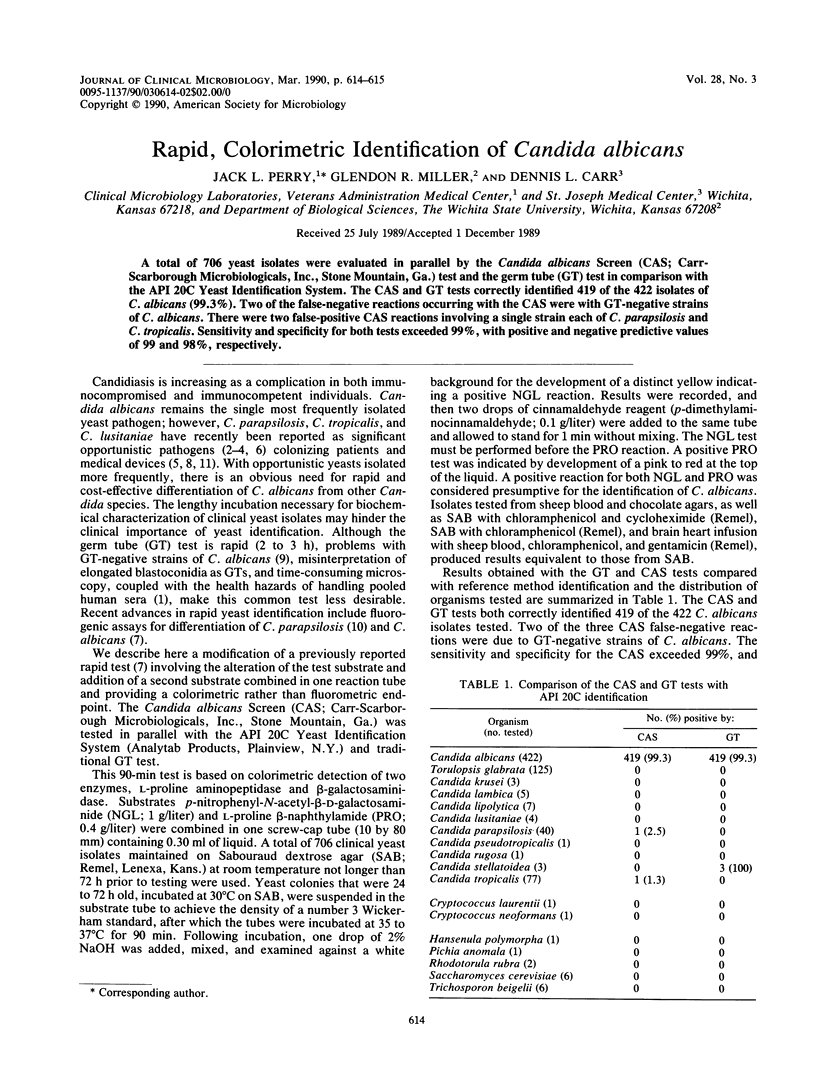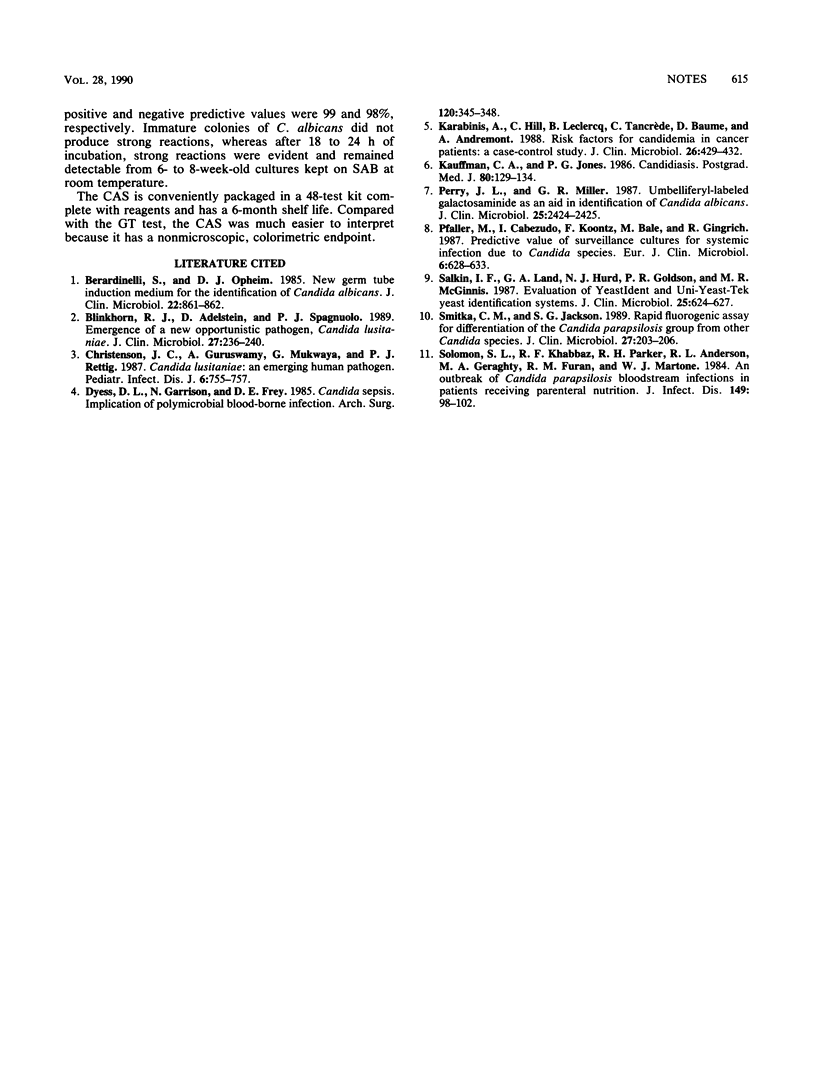Abstract
A total of 706 yeast isolates were evaluated in parallel by the Candida albicans Screen (CAS; Carr-Scarborough Microbiologicals, Inc., Stone Mountain, Ga.) test and the germ tube (GT) test in comparison with the API 20C Yeast Identification System. The CAS and GT tests correctly identified 419 of the 422 isolates of C. albicans (99.3%). Two of the false-negative reactions occurring with the CAS were with GT-negative strains of C. albicans. There were two false-positive CAS reactions involving a single strain each of C. parapsilosis and C. tropicalis. Sensitivity and specificity for both tests exceeded 99%, with positive and negative predictive values of 99 and 98%, respectively.
Full text
PDF

Selected References
These references are in PubMed. This may not be the complete list of references from this article.
- Berardinelli S., Opheim D. J. New germ tube induction medium for the identification of Candida albicans. J Clin Microbiol. 1985 Nov;22(5):861–862. doi: 10.1128/jcm.22.5.861-862.1985. [DOI] [PMC free article] [PubMed] [Google Scholar]
- Blinkhorn R. J., Adelstein D., Spagnuolo P. J. Emergence of a new opportunistic pathogen, Candida lusitaniae. J Clin Microbiol. 1989 Feb;27(2):236–240. doi: 10.1128/jcm.27.2.236-240.1989. [DOI] [PMC free article] [PubMed] [Google Scholar]
- Christenson J. C., Guruswamy A., Mukwaya G., Rettig P. J. Candida lusitaniae: an emerging human pathogen. Pediatr Infect Dis J. 1987 Aug;6(8):755–757. [PubMed] [Google Scholar]
- Dyess D. L., Garrison R. N., Fry D. E. Candida sepsis. Implications of polymicrobial blood-borne infection. Arch Surg. 1985 Mar;120(3):345–348. doi: 10.1001/archsurg.1985.01390270083014. [DOI] [PubMed] [Google Scholar]
- Karabinis A., Hill C., Leclercq B., Tancrède C., Baume D., Andremont A. Risk factors for candidemia in cancer patients: a case-control study. J Clin Microbiol. 1988 Mar;26(3):429–432. doi: 10.1128/jcm.26.3.429-432.1988. [DOI] [PMC free article] [PubMed] [Google Scholar]
- Kauffman C. A., Jones P. G. Candidiasis. A diagnostic and therapeutic challenge. Postgrad Med. 1986 Jul;80(1):129–134. doi: 10.1080/00325481.1986.11699455. [DOI] [PubMed] [Google Scholar]
- Perry J. L., Miller G. R. Umbelliferyl-labeled galactosaminide as an aid in identification of Candida albicans. J Clin Microbiol. 1987 Dec;25(12):2424–2425. doi: 10.1128/jcm.25.12.2424-2425.1987. [DOI] [PMC free article] [PubMed] [Google Scholar]
- Pfaller M., Cabezudo I., Koontz F., Bale M., Gingrich R. Predictive value of surveillance cultures for systemic infection due to Candida species. Eur J Clin Microbiol. 1987 Dec;6(6):628–633. doi: 10.1007/BF02013057. [DOI] [PubMed] [Google Scholar]
- Salkin I. F., Land G. A., Hurd N. J., Goldson P. R., McGinnis M. R. Evaluation of YeastIdent and Uni-Yeast-Tek yeast identification systems. J Clin Microbiol. 1987 Apr;25(4):624–627. doi: 10.1128/jcm.25.4.624-627.1987. [DOI] [PMC free article] [PubMed] [Google Scholar]
- Smitka C. M., Jackson S. G. Rapid fluorogenic assay for differentiation of the Candida parapsilosis group from other Candida spp. J Clin Microbiol. 1989 Jan;27(1):203–206. doi: 10.1128/jcm.27.1.203-206.1989. [DOI] [PMC free article] [PubMed] [Google Scholar]
- Solomon S. L., Khabbaz R. F., Parker R. H., Anderson R. L., Geraghty M. A., Furman R. M., Martone W. J. An outbreak of Candida parapsilosis bloodstream infections in patients receiving parenteral nutrition. J Infect Dis. 1984 Jan;149(1):98–102. doi: 10.1093/infdis/149.1.98. [DOI] [PubMed] [Google Scholar]


